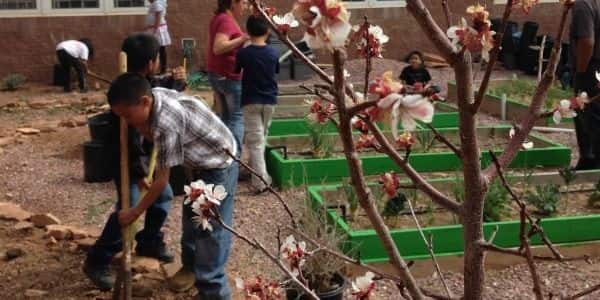In Leupp, Arizona, when it rains, it pours … and pours … and then it may not pour again for months. To make the most of these sporadic, dramatic rainstorms, Leupp Public School used their Whole Kids Foundation Garden Grant to install a high-capacity water collection system.
“It rains infrequently, and then when it does rain, it’s a deluge,” explains Andrea Hartley, development director and community garden coordinator for Terra Birds, a nonprofit that has partnered with Leupp Public School to help coordinate the garden program, and to provide lessons and materials.
“The school is located on a Navajo reservation,” Andrea explains. “It’s a challenging climate and the area is very isolated, so it’s considered a food desert. The nearest grocery store is a 45-minute drive. Some students come from families with long-standing farming traditions, but even families that grow some of their own food are not able to grow all of it.”
Students at Leupp Public School grow a variety of veggies and fruits, including beans, peas, carrots, radishes, melons, tomatoes, lettuces, kale and an apricot tree. They also grow many traditional Navajo foods and medicinal plants, such as blue corn, yucca and sage, that thrive even in the dry, hot climate.
Naturally, water conservation has become a cornerstone of the school garden program.
“Because of the heavy, infrequent rains, we had to design our water collection system to manage a high volume of input,” Andrea explains. “The main rainwater collection tank has a very large opening to collect water from one side of the roof that borders the garden. Once the tank is full, usually after just one rainstorm, that can provide up to a month of watering the gardens.”
“The main rainwater collection tank has a very large opening to collect water from one side of the roof that borders the garden. Once the tank is full, usually after just one rainstorm, that can provide up to a month of watering the gardens.”
The enormous tank, which holds 275 gallons, was originally an industrial food-grade transport container, salvaged from a water treatment plant. The school was able to purchase it from the city at a very low cost. A Terra Birds staff member helped with designing and installing the rainwater collection system, sourcing materials, and provided instruction for students, primarily in grades 3-5, who helped with the installation.
With this system, the water is now distributing valuable rainwater in two focused directions. One downspout directs water through a swale away from the building and into a wide, shallow low spot, which will be planted with appropriate native plants. The other downspout flows into the catchment tank that, when full, overflows into the courtyard pollinator garden.
While the rainwater system captures as much as possible from big rains, a separate drip irrigation system ensures the most efficient use of water from the tap during long dry stretches. The long-term goal is to eventually connect the rainwater system and the irrigation system.
“We are planning on another rainwater tank to boost capacity,” Andrea says. “Then maybe we can run an irrigation system off of it. Right now our drip system is hooked up to a spigot near the garden and is set on a timer. It goes to six raised beds, which is most of the school’s garden.”
Drip irrigation has many benefits: it keeps the amount and time of watering consistent; cuts down on water waste and evaporation loss because drip lines are buried along the base of the roots; and the system can be customized if one type of plant needs more water than another.
“It’s great to get the kids involved in planning and construction of these systems,” Andrea says. “It gets them to think about where water comes from, and how they can conserve it and use it in a sustainable way.”
Rainwater harvesting resources:
http://www.harvestingrainwater.com/
http://espanol.projectwet.org/system/files/materials/rw_harvesting_english.pdf
http://greywateraction.org/contentabout-rainwater-harvesting/
Make the Most of Every Drop
Before installing an irrigation or water collection system, do your research and plan ahead to make the most of your investment. Andrea shares her planning tips:
- Before putting a system in place, determine who is responsible for maintaining it in the long term. These systems require ongoing maintenance, so make sure you have resources to make it sustainable.
- For irrigation systems, it’s critical to monitor regularly (daily or weekly) to make sure it runs correctly and at scheduled times. If there is a problem with the timer or a leak in the system, it’s important to catch it quickly so your plants don’t go days with too little (or too much) water. Don’t wait for the plants to tell you something is wrong!
- Portions of a drip irrigation system may be difficult to see, hidden beneath mulch or rocks. At least monthly, check for hidden cracks or extra holes that could cause excess water loss. Also check for clogs in the system, and verify that every area is getting the amount of water it needs.
- Rainwater collection systems should be checked at least once per month to monitor the flow, check for leaks or blockages, and check that hoses and fittings are tight. After every growing season, it’s also a good idea to flush out the tank and clean out any gunk.
- Keep rainwater tanks covered, so things cannot fall in. Always keep water flowing, not stagnant. In areas where mosquitos are a concern, monitor to ensure the system is not creating a breeding ground for larvae.



